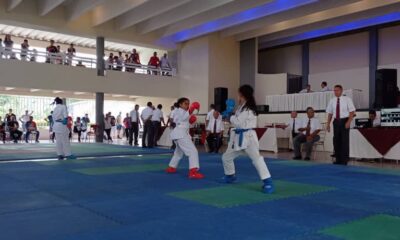Tecnología
Así se vive el eclipse solar anular de este #14Oct (+videos, imágenes)

Este 14 de octubre millones de personas de diversos países de América, disfrutan de un nuevo eclipse solar anular, llamado también “anillo de fuego” por la figura que forma la luz solar al rodear la sombra de la Luna.
Los habitantes de Oregón, Nevada, Utah, Texas y Nuevo México, pudieron disfrutar del espectáculo desde sus primeras fases.
Luego, el eclipse cruzó a Centroamérica y llegará a su fase final en América del Sur y culminará con el atardecer sobre el Océano Atlántico. México, Belice, Honduras, Panamá, Colombia Venezuela y Brasil también disfrutan del “anillo de fuego”.
Según lo explicado por la Nasa, este eclipse solar anular se pudo apreciar principalmente desde el Hemisferio Occidental de nuestro planeta, incluyendo zonas de América del Norte, Centroamérica y parte de Sudamérica.
A Través de las redes sociales los usuarios colgaron imágenes y videos de cómo se apreciaba el fenómeno desde donde se encontraban.
No obstante, hubo zona en donde las nubes no permitieron a los espectadores gozar del todo de este espectáculo.
Desde las 10: 13 am llegaron los primeros reportes desde Estados Unidos, en Venezuela a eso de las 2:00 pm los internautas daban data de que el fenómeno ya era visible.
Un eclipse solar anular significa que la Luna, situada en un punto alejado de la órbita terrestre, no llega a cubrir completamente el Sol al pasar entre este y la Tierra, dejando un anillo de luz solar visible a todo su alrededor: el llamado anillo de fuego.
#14Oct #EclipseSolar@Sulli_g: Vista del eclipse del "anillo de fuego" desde el desierto de Nevada, Estados Unidos. pic.twitter.com/NoF4EYogfP
— Reporte Ya (@ReporteYa) October 14, 2023
https://twitter.com/ElUniversal/status/1713263931655942189
https://twitter.com/UNoticias/status/1713252119430451684
https://twitter.com/LuissLm/status/1713266465514668453
Con información de ACN/ National Geographic
No deje de leer: Mantenimiento preventivo evita fallas inesperadas en infraestructuras críticas
Infórmate al instante únete a nuestro canal de Telegram NoticiasACN
Tecnología
LG Electronics (LG) recibió 28 reconocimientos en los Premios Red Dot

LG Electronics dio a conocer que recibió un total de 28 galardones en la más reciente edición de los Premios Red Dot.
Entre los múltiples reconocimientos se encuentran dos premios Best of the Best para LG CLOi ServeBot y los hornos de pared de la Serie Transicional Signature Kitchen Suite.
Reconocido con un honor Best of the Best, LG CLOi ServeBot incorpora tecnología innovadora en un diseño elegante con estabilidad en mente.
Para mayor comodidad y versatilidad, el robot autónomo de servicio cuenta con estantes de tres niveles que se pueden ajustar o desmontar según la situación e incluso puede soportar hasta 40 kilogramos, facilitando el movimiento de cargas pesadas.
Ofreciendo un rendimiento de conducción mejorado con seis ruedas y suspensión independiente, el CLOi ServeBot puede incluso moverse de manera estable en suelos inestables.
Equipado con una cámara 3D y un sensor de detección y alcance de luz (LiDAR), el CLOi ServeBot puede reconocer entornos y comunicarse con otros CLOi ServeBot para coordinar movimientos sin puntos de acceso, permitiendo la operación estable de más de diez robots en el mismo espacio simultáneamente.
Con tecnología sobresaliente, el CLOi ServeBot recibió el Premio a la Innovación en CES 2024.
También galardonados con el Best of the Best, los hornos de pared de la Serie Transicional de Signature Kitchen Suite fueron reconocidos por su diseño moderno y minimalista con un elegante acabado mate aterciopelado que eleva el entorno de la cocina.
Ofreciendo una apariencia chic y minimalista, los hornos de la Serie Transicional están equipados con manijas más delgadas que las que se encuentran en los modelos de la Serie Profesional.
Más de los Premios Red Dot que se llevó LG Electronics
Equipados con la tecnología Gourmet AI™ y una cámara de alta definición incorporada, los hornos pueden identificar ingredientes y sugerir automáticamente recetas óptimas en la pantalla.
A través de la aplicación LG ThinQ™, los usuarios pueden monitorear lo que están cocinando en tiempo real e incluso capturar videos y fotos en time-lapse.
LG StanbyME Go, una pantalla portátil de 27 pulgadas integrada en un estuche, fue reconocida como un Producto Innovador y Ganador en los Premios Red Dot de este año
. Completo con un sistema de sonido Dolby Atmos integrado, conectividad HDMI y webOS, StanbyME Go ofrece una experiencia de entretenimiento completa en cualquier lugar que desee.
LG StanbyME Go es la pantalla de entretenimiento móvil ideal con sus altavoces de 40W y un brazo articulado que puede posicionar la pantalla en tres formas diferentes.
Protegido por su estuche de grado militar, los usuarios pueden disfrutar de su contenido dentro y fuera del hogar, llevarlo a eventos deportivos, acampar y a cualquier lugar donde los lleven sus viajes.
Otras innovaciones reconocidas por su diseño sobresaliente incluyen el último televisor, laptop, monitor, altavoz, acondicionadores de aire, lavadoras y secadoras, Styler, sistema de planchado todo en uno, deshumidificador y HydroTower de LG, una combinación de purificador de aire y humidificador.
El Premio Red Dot es uno de los concursos más respetados en el mundo del diseño de productos, diseño de comunicación y conceptos de diseño.
“LG continuará brindando una experiencia cálida e innovadora al cliente con un diseño adaptado a los estilos de vida de los usuarios junto con las soluciones únicas de vida inteligente de la compañía”, comentó Hwang Sung-gul, jefe del Centro de Diseño Corporativo de LG Electronics.

Con información de nota de prensa
Te invitamos a leer
Ciudad de Miami reconoce a hispana por su aporte a expertas profesionales
Infórmate al instante únete a nuestro canal de Telegram NoticiasACN
-

 Internacional3 horas ago
Internacional3 horas agoFundación denuncia desaparición de 77 venezolanos en isla de San Andrés
-

 Carabobo19 horas ago
Carabobo19 horas agoAlcalde Fuenmayor invita a disfrutar de la 19° edición de la Filven Carabobo
-

 Nacional14 horas ago
Nacional14 horas agoEste es el audio con el que Tarek William Saab, vinculó a opositores con trama Pdvsa
-

 Carabobo16 horas ago
Carabobo16 horas agoTaller de Poesía 2024 iniciará este 15 de mayo en Dirección Central de Cultura UC

















